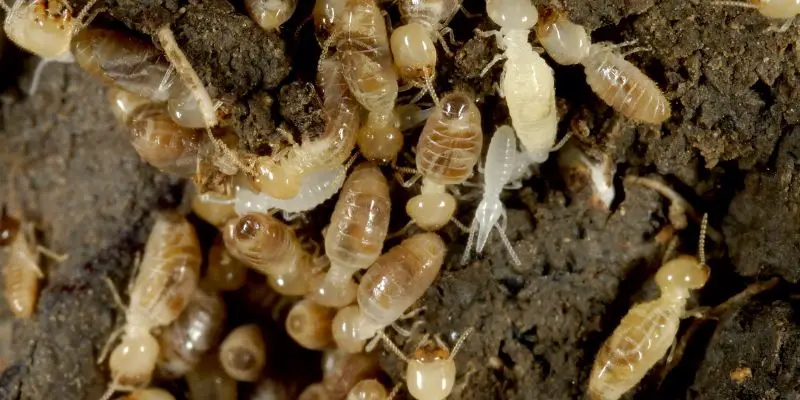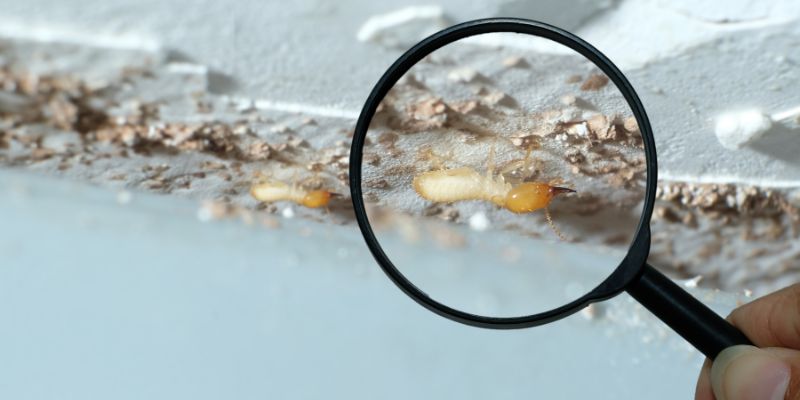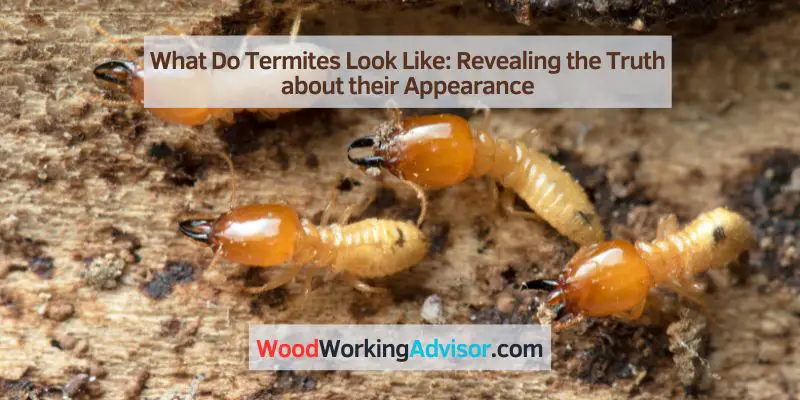Termites look like small, pale insects with soft bodies and straight antennae. They are usually about ¼ to ½ inch long and can vary in color from white to light brown.
These destructive pests have six legs and often have straight, rather than elbowed, antennae. Termites are best identified by their pale color and soft bodies, and they can be found in swarming groups or near damaged wood. Understanding their appearance can help in identifying and addressing a potential termite infestation before they cause significant damage to your property.
If you suspect termite activity, it’s essential to seek professional pest control assistance promptly to prevent further destruction.
Unveiling Termite Identity
As homeowners, it’s crucial to recognize the appearance of termites to protect our properties from potential structural damage. The ability to identify these tiny wood-eating pests at an early stage is essential for preventing extensive and costly infestations. In this article, we will delve into the definition and brief description of termites, highlighting the importance of recognizing their appearance.
Definition And Brief Description Of Termites
Termites are small, pale insects that belong to the order Isoptera. These social insects live in colonies and are known for their ability to feed on wood, causing significant damage to buildings and wooden structures. The three main types of termites are subterranean termites, drywood termites, and dampwood termites. Each type has distinct characteristics and behaviors that influence their appearance and habits.
The Importance Of Recognizing Termite Appearance
Recognizing termite appearance is crucial for homeowners as early detection can prevent extensive damage to their properties. Understanding the physical features of termites, such as their size, color, and behavior, enables homeowners to identify potential infestations and take proactive measures to address them. By being able to distinguish termites from other insects, individuals can effectively protect their homes and minimize the risk of structural harm caused by these destructive pests.

Termite Appearance Explained
When it comes to termite appearance, understanding their physical characteristics is crucial for their identification and prevention. Termite appearance can vary based on species and caste within the colony. Exploring the size and color variations of termites as well as their distinctive physical features like wings, antennae, and body segments can assist homeowners and pest control professionals in effectively differentiating termites from other insects. Let’s delve deeper into the visual aspects of termites in order to become more informed about these destructive pests.
Size And Color Variations Of Termites
Termites come in different sizes and colors based on their role within the colony. The typical sizes of worker, soldier, and reproductive termites range from a few millimeters to about an inch. Workers are generally smaller in size, while soldiers are slightly larger, equipped with powerful jaws for defense. Reproductive termites, also known as alates or swarmers, are the largest and most recognizable due to their wings.
Distinctive Physical Features: Wings, Antennae, And Body Segments
One of the most distinctive physical features of termites is their wings. Swarming termites, especially during the mating season, are equipped with two pairs of wings of equal length. These wings are shed after mating, leaving distinct wing scars on the bodies of individuals. Termites also have straight, bead-like antennae and a specialized body consisting of three distinct segments: head, thorax, and abdomen. The combination of these physical attributes makes it easier to differentiate termites from other insects like ants, which share similar habitats but have notably different appearances.
What Do Termites Look Like: A Detailed Walkthrough
Worker Termites: The Laborers In The Colony
Worker termites are the labor force of the termite colony. These soft-bodied insects are typically white or creamy in color and measure about 1/4 inch long. They are responsible for carrying out the essential tasks of the colony such as building and repairing the nest, foraging for food, and feeding other members of the colony.
Soldier Termites: The Protectors With Distinctive Features
Soldier termites are equipped with powerful jaws and are responsible for defending the colony against predators. They are typically larger than worker termites and have elongated, dark-colored heads. Their mandibles are their primary weapon, used to fend off threats to the colony’s safety.
Reproductive Termites: Kings, Queens, And Alates (swarmers)
Reproductive termites are the primary reproductives in the colony. Kings and queens are responsible for the perpetuation of the colony and can live for many years. Alates, or swarmers, are the sexually mature individuals that leave the colony in large numbers during swarming season to establish new colonies. They are distinguished by their dark-colored bodies, straight antennae, and four equal-sized wings.
Termites Vs Other Insects
When it comes to identifying termites, it’s important to distinguish them from other household pests such as ants and beetles. Understanding the differences between termites and other insects can help homeowners in proper pest control and prevention measures.
Comparing Termites To Ants
Termites and ants are often mistaken for each other due to their similar body shapes and sizes. While both insects have a narrow waist and segmented bodies, there are distinct differences to note. Unlike ants, termites have straight antennae, a thick waist, and equal-sized wings. Ants, on the other hand, have elbowed antennae, a narrow waist, and wings of unequal size.
Comparing Termites To Beetles
Termites are frequently confused with beetles, especially as both insects can infest wood. However, termites have straight, bead-like antennae and soft bodies, while beetles have hardened forewings covering the hindwings. Additionally, termites have a broad waist and equal-sized wings, while beetles have a narrower waist and different-sized wings. Understanding these differences can help in accurate pest identification.
Comparing Termites To Other Household Pests
When it comes to distinguishing termites from other common household pests, such as cockroaches and bed bugs, it’s crucial to examine their behavior and habitat. Termites are known for their destructive behavior towards wood and paper products, whereas bed bugs and cockroaches thrive in different environments and feed on different food sources.
Identifying Termites Based On Behavior And Habitat
In addition to their distinctive physical characteristics, termites can be identified based on their behavior and habitat. Unlike many household pests, termites construct mud tubes and live in colonies, making their presence more evident in certain areas of a home. Understanding the habits and habitats of termites is essential for effective pest management.
Recognizing Signs Of Termite Presence
When it comes to protecting your home from damage caused by termites, recognizing the signs of their presence is crucial. By understanding what termites look like and the common indicators of an infestation, you can take effective measures to detect and address any issues before they escalate. This article will provide you with valuable insights into spotting termite damage, common indicators of a termite infestation, and effective strategies for detecting termites around your home.
Spotting Termite Damage Around The Home
If you suspect termite activity in your home, it’s important to be able to recognize the signs of termite damage. This can include:
- Wood damage: Look for hollow-sounding or sagging wood, as well as small holes in the wood surface.
- Mud tubes: These are small tunnels made of soil or dirt particles and are often found near the foundation of a home.
- Discarded wings: Termites shed their wings after swarming, so finding discarded wings near windowsills or on the ground can indicate their presence.
Common Indicators Of A Termite Infestation
Recognizing the common indicators of a termite infestation can help you take proactive measures to address the problem. Some common signs include:
- Visible swarmers: These are winged termites that are often mistaken for flying ants. If you notice them indoors, especially near light sources, it could be a sign of a termite infestation.
- Tight-fitting doors and windows: Termites create moisture as they feed on wood, which can cause doors and windows to become difficult to open or close.
- Bubbling or peeling paint: Termites can cause the paint on walls or wood surfaces to bubble or peel, as they feed on the wood beneath.
Effective Strategies For Termite Detection
Implementing effective strategies for detecting termites is essential for protecting your home from damage. Some effective detection methods include:
- Regular inspections: Conducting regular visual inspections of your home, particularly in areas prone to moisture, can help you identify early signs of termite activity.
- Using termite baits: Placing termite baits or monitors around your property can help in detecting termite activity.
- Seeking professional help: Hiring a professional pest control expert to conduct thorough termite inspections can provide you with peace of mind and valuable insights into any potential infestations.
Revealing The Truth About Their Appearance
Termites are often not given the attention they deserve, especially in terms of their physical appearance. In this section, we’ll debunk myths and misconceptions about termite appearances and explore how understanding their appearance can aid in prevention and control.
Myths And Misconceptions About Termite Appearances
Before diving into the reality of what termites look like, it’s essential to address the common misconceptions surrounding their appearance. One prevalent myth is that termites are visible to the naked eye, but in reality, they are often mistaken for ants due to their similar size and color. Another misconception is that termites have wings throughout their life, when in fact, only certain types of termites have wings, and they shed them after swarming.
How Understanding Termite Appearance Can Aid In Prevention And Control
By familiarizing ourselves with the physical characteristics of termites, we can better prepare for prevention and control measures. Identifying a termite infestation early on greatly improves the chances of effective treatment. Moreover, understanding the appearance of termites allows for proactive measures to be taken in vulnerable areas of a property, helping to prevent infestations before they even begin.

Preventing Misidentification And Missteps
The Consequences Of Misidentifying Pests
Misidentifying pests, especially termites, can lead to serious implications for homeowners. Termites, if left unchecked, can cause extensive damage to wooden structures, leading to costly repairs. Identifying pests incorrectly could result in ineffective treatment measures, allowing the infestation to worsen. Addressing the issue promptly starts with accurate identification.
Professional Assessment And The Role Of Expert Identification
Seeking professional assessment is crucial when dealing with potential termite infestations. Professionals have the expertise to accurately identify pests and assess the level of infestation. This can prevent missteps in treatment and ensure that the appropriate measures are implemented to eradicate the termites effectively.
Encouraging Proactive Measures And Regular Inspections
To prevent misidentification of termites, it’s essential for homeowners to adopt proactive measures, such as regular inspections. By being vigilant and conducting routine checks for signs of termite activity, homeowners can address potential infestations early on, minimizing the risk of misidentification and subsequent damage to their properties.
Frequently Asked Questions On What Do Termites Look Like
How Do You Know You Have Termites?
Signs of termite infestation include hollow wood, mud tubes, and discarded wings. Look for these indicators and book a professional inspection for confirmation.
What Do Termites Look Like To The Human Eye?
Termites are small insects with pale colors. They typically measure around 0. 25 inches in length. Their bodies have a distinct waist and straight, beaded antennae. Wings, if present, are milky or clear and equally sized.
What Do Indoor Termites Look Like?
Indoor termites are small, pale insects with straight, beaded antennae and a thick waist. They have straight wings and are often mistaken for ants. They are around 1/4 inch long and have a soft body.
What Is The Bug That Looks Like A Termite?
The bug that looks like a termite is the termite beetle. It resembles termites but has distinct body segments and straight antennae.
Conclusion
Knowing what termites look like is crucial for identifying and preventing infestations. By recognizing their physical characteristics, homeowners can take proactive measures to protect their properties. Understanding the appearance of termites is the first step in safeguarding your home against potential damage.
Stay informed and vigilant to ensure your property remains termite-free.


